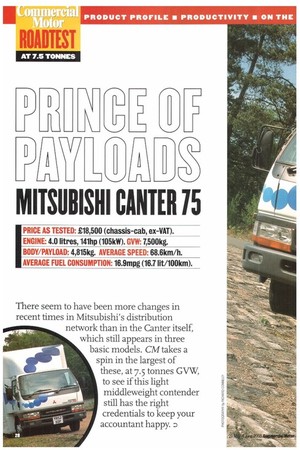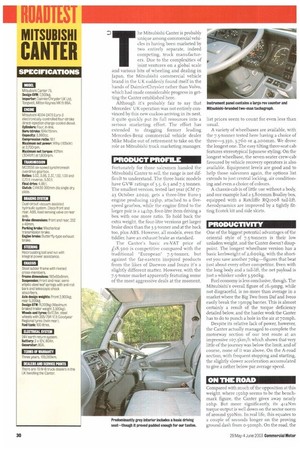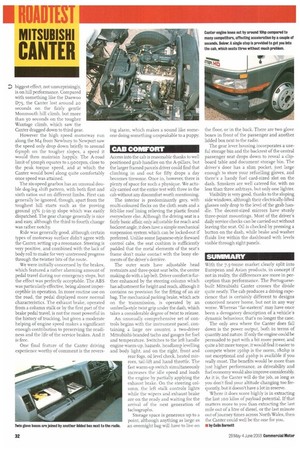ITSUBISHI CANTER 75
Page 28

Page 30

Page 32

If you've noticed an error in this article please click here to report it so we can fix it.
[PRICE AS TESTED: 118,500 (chassis-cab, ex-VAT). ENGINE: 4.0 litres, 141hp (105kW). GVW: 7,500kg. BODY/PAYLOAD: 4,815kg. AVERAGE SPEED: 68.6km/h. AVERAGE FUEL CONSUMPTION: 16.9mpg (16.7 lit/100km).
There seem to have been more changes in recent times in Mitsubishi's distribution network than in the Canter itself, which still appears in three basic models. CM takes a spin in the largest of these, at 7.5 tonnes GVW, to see if this light middleweight contender still has the right credentials to keep your accountant happy. D
he Mitsubishi Canter is probably unique among commercial vehicles in having been marketed by two entirely separate, indeed competing, truck manufacturers. Due to the complexities of joint ventures on a global scale and various bits of wheeling and dealing in Japan, the Mitsubishi commercial vehicle brand in the UK suddenly found itself in the hands of DaimlerChrysler rather than Volvo, which had made considerable progress in getting the Canter established here.
Although it's probably fair to say that Mercedes' UK operation was not entirely convinced by this new cuckoo arriving in its nest, it quite quickly put its full resources into a serious marketing effort. The effort has extended to dragging former leading Mercedes-Benz commercial vehicle dealer Mike Mudie out of retirement to take on the role as Mitsubishi truck marketing manager.
PRODUCT PROFILE
Fortunately for those salesmen handed the Mitsubishi Canter to sell, the range is not difficult to understand. The three basic models have GVW ratings of 3.5, 6.3 and 7.5 tonnes. The smallest version, tested last year (CM 1723 October 2002), gets a three-litre Euro-3 engine producing 12311p, attached to a fivespeed gearbox, while the engine fitted to the larger pair is a 1.4ihp, four-litre item driving a box with one more ratio. To hold back the extra weight, the four-litre versions get larger brake discs than the 3.5-tonner and at the back too, plus ABS. However, all models, even the tiddler, have an exhaust brake as standard.
The Canter's basic ex-VAT price of it8,5 o is competitive compared with the traditional "European" 7.5-tonner, but against the far-eastern inspired products from the likes of Daewoo and I suzu it's a slightly different matter. However, with the 7.5-tonne market apparently featuring some of the most aggressive deals at the moment,
list prices seem to count for even less than usual.
A variety of wheelbases are available, with the 7.5-tonner tested here having a choice of three-3,35o, 3,760 or 4, zoomm. We drove the longest one. The easy tilting three-seat cab features stereotypical Japanese styling. On the longest wheelbase, the seven-seater crew-cab favoured by vehicle recovery operators is also available. Equipment levels are good and to help those salesmen again, the options list extends to just central locking, air conditioning and even a choice of colours.
A chassis-cab is of little use without a body, and our example had a 5,800mm Boalloy box, equipped with a Ratcliffe RQIoo8 tail-lift. Aerodynamics are improved by a tightly fitting Ecotek kit and side skirts.
PRODUCTIVITY
One of the biggest potential advantages of the oriental style of 7.5-tonners is their low unladen weight, and the Canter doesn't disappoint. The longest wheelbase version has a basic kerbweight of 2, 600kg, with the shortest you save another 70kg—figures that beat just about every other competitor. Even with the long body and a tail-lift, the net payload is just a whisker under 3,500kg.
Fuel economy is less conclusive, though. The Mitsubishi's overall figure of 16.9mpg, while not disgracefiil, is no more than average in a market where the Big Two from Daf and Iveco easily break the rgmpg barrier. This is almost certainly a result of the torque deficiency detailed below, and the harder work the Canter has to do to punch a hole in the air at 70mph.
Despite its relative lack of power, however, the Canter actually managed to complete the motorway section of our test route at an impressive 107.5km/h which shows that very little of the journey was below the limit, and of course, none of it was above. On the A-road section, with frequent stopping and starting, the slightly slower acceleration accumulated 70 give a rather below par average speed.
ON THE ROAD
Compared with much of the opposition at this weight, where i5ohp seems to be the benchmark figure, the Canter gives away nearly rohp. But more significantly, its 412Islm torque output is well down on the sector norm of around 55 oNm. In real life, this equates to a couple of seconds longer on the proving ground dash from o-omph. On the road, the
biggest effect, not unsurprisingly, is on hill performance. Compared with something like the Daewoo D75, the Canter lost around 2o seconds on the fairly gentle Monmouth hill climb, but more than 3o seconds on the tougher Wantage climb, which saw the Canter dragged down to third gear.
However the high speed motorway run along the M4 from Newbury to Newport saw the speed only drop down briefly to around 65mph on the tougher slopes, a speed it would then maintain happily. The A-road limit of somph equates to r,9oorpm, close to the peak torque speed, and at which the Canter would bowl along quite comfortably once speed was attained.
The six-speed gearbox has an unusual double dog-leg shift pattern, with both first and sixth ratios out on different limbs. First can generally be ignored, though, apart from the toughest hill starts such as the proving ground 33% (I-in-3) slope which was easily dispatched. The gear change generally is nice and easy, although the third to fourth change was rather notchy.
Ride was generally good, although certain types of motorway surface didn't agree with the Canter, setting up a resonance. Steering is very positive, and combined with the lack of body roll to make for very unstressed progress through the twistier bits of the route.
We were initially concerned by the brakes, which featured a rather alarming amount of pedal travel during our emergency stops, but the effect was perfectly acceptable. The ABS was particularly effective, being almost imperceptible in operation. In more routine use on the road, the pedal displayed more normal characteristics. The exhaust brake, operated from a column stalk or by the first part of the brake pedal travel, is not the most powerful in the history of trucking, but given a moderate helping of engine speed makes a significant enough contribution to preserving the readiness and the life of the service brakes. And it is free.
One final feature of the Canter driving experience worthy of comment is the revers
ing alarm, which makes a sound like someone doing something unspeakable to a puppy.
CAB COMFORT
Access into the cab is reasonable thanks to well positioned grab handles on the A-pillars, but the larger framed parcels driver could find that climbing in and out for fifty drops a day becomes tiresome. Once in, however, there is plenty of space for such a physique. We actually carried out the entire test with three in the cab without any discomfort worth mentioning.
The interior is predominantly grey, with multi-coloured flecks on the cloth seats and a felt-like roof lining relieving the plastic found everywhere else. Although the driving seat is a fairly basic affair, only adjustable for reach and backrest angle, it does have a simple mechanical suspension system which can be locked-out if preferred. Unlike some Japanese-style forward control cabs, the seat cushion is sufficiently padded that the metal elements of the seat's frame don't make contact with the bony elements of the driver's derriere.
The outer seats have adjustable head restraints and three-point seat belts, the centre making do with a lap belt. Driver comfort is further enhanced by the steering column which has adjustment for height and reach, although it contains no provision for the fitting of an air bag. The mechanical parking brake, which acts on the transmission, is operated by an umbrella-style twist grip under the dash, which takes a considerable degree of twist to release.
An unusually comprehensive set of controls begins with the instrument panel, containing a large rev counter, a two-driver Mitsubishi-branded tacho and gauges for fuel and temperature. Switches to the left handle engine warm-up, hazards, headlamp levelling and body light, and on the right, front and rear fogs, oil level check, heated mirrors, tail-lift and hand throttle. The fast warm-up switch simultaneously increases the idle speed and loads the engine by partially applying the exhaust brake. On the steering column, the left stalk controls lights while the wipers and exhaust brake are on the ready and waiting for the arrival of the next generation of tachographs.
Storage space is generous up to a point, although anything as large as an overnight bag will have to live on the floor, or in the back. There are two glove boxes in front of the passenger and another lidded box next to the radio.
The gear lever housing incorporates a useful storage bin and the backrest of the central passenger seat drops down to reveal a clipboard table and document storage bin. The driver's door has a slim pocket, just large enough to store your refuelling gloves, and there's a handy fuel card-sized slot on the dash. Smokers are well catered for, with no less than three ashtrays, but only one lighter.
Visibility is very good, thanks to the sloping side windows, although their electrically-lifted glasses only drop to the level of the grab handle. The decent-sized mirrors have sturdy three-point mountings. Most of the driver's daily service checks can be carried out without leaving the seat. Oil is checked by pressing a button on the dash, while brake and washer fluids live within the dashboard with levels visible through sight panels.
SUMMARY
With the 7.5-tonne market clearly split into European and Asian products, in concept if not in reality, the differences are more in perception than performance. The Portuguesebuilt Mitsubishi Canter crosses the divide quite neatly. The cab produces a driving experience that is certainly different to designs conceived nearer home, but not in any way worse. Whereas "far-eastern" may have once been a derogatory description of a vehicle's dynamic behaviour, that's no longer the case.
The only area where the Canter does fail down is the power output, both in terms of quantity and nature. If only the engine could be persuaded to part with a bit more power, and quite a bit more torque, it would find it easier to compete where 15ohp is the norm, r8ohp is not exceptional and 23ohp is available if you really must, The benefits would be more than just higher performance, as driveability and fuel economy would also improve considerably. As it is, the Canter will do the job, as long as you don't find your altitude changing too frequently, but it doesn't have a lot in reserve.
Where it does score highly is in extracting the last roo kilos of payload potential. If that matters more to you than extracting the last mile out of a litre of diesel, or the last minute out ofjourney times across North Wales, then the Canter could well be the one for you.
• by Colin Barnett
























































































































































